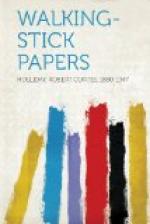Sometimes the mention, made necessary in connection with plans for some public improvement, of a well-known river, say, revealed the town’s location. Occasionally the comparative antiquity of the civilisation supplied inspiration for a good guess as to its situation—that it was the town of that name in New England rather than the one in Oklahoma. Multiplied clues of identity, again, built up a case: “Official Ballot” (ran the title) “for Precinct W. Attleburough, Tuesday. Nov. 3, 1896.” The name “Wm. M. Olin” was given as that of the “Secretary of the Commonwealth.” Of the first page that was all. In heaven’s name! exclaimed the cataloguer, what commonwealth? A study of the list of candidates on this ballot, giving their places of residence, however, fortified one’s natural supposition—“of Worcester, of Lynn, of Haverhill, of Amherst, of Pittsfield” (ah!), “of Boston.” It is a reasonable surmise that this Ballot pertains to the commonwealth of Massachusetts.
It is not here stated that the name of its native State is never discovered in the whole of any American municipal document. Often, in some indirect allusion, somewhere in the text it may be found. Frequently, too, it is true, the State seal is printed upon the title page or cover of the volume. And in instances the name of the State stands out clearly enough upon the page of title. But in case after case, in the occupation giving rise to this paper, the only expedient was recourse to a file of city directories, collating names of streets in these with those mentioned in the documents.
Another curious idiosyncrasy of one branch of public document—which informs the labour of cataloguing them with something of the alluring fascination of putting together jig-saw picture puzzles ("spoke,” in the words of Artemas Ward, “sarcastic”) is the extraordinary variety of names that can be found by municipalities to entitle the Mayor’s annual eloquence. This versatile character may deliver himself of an Annual Address, Message, Communication, Statement, or of “Remarks.”
A cataloguer was surprised to discover, in “An Act to Incorporate and Vest Certain Powers in the Freeholders and Inhabitants of the village of Brooklyn, in the County of Kings,” the prophetic enlightenment of the Inhabitants of that village in the year 1816. The voice of Andrew Carnegie, Colonel Roosevelt, and Prof. Brander Matthews speaks in the following passage: “That the section of the town of Brooklyn, commonly known as ‘The Fire District,’ and contained within the following bounds, viz.: Beginning at the public landing south of Pierpont’s distillery, formerly the property of Philip Livingston, deceased, on the East River, thence running along the public road leading from said landing to its intersection with Redhook lane, thence along Redhook lane to where it intersects Jamaica turnpike road, thence a North East course to the head of the Wallabaght mill-pond, thence thro the centre of said mill pond to the East river, and thence down the East river to the place of beginning, shall continue to be known and distinguished by the Name of the Village of Brooklyn.” “Thro” certainly is phonetic spelling.




